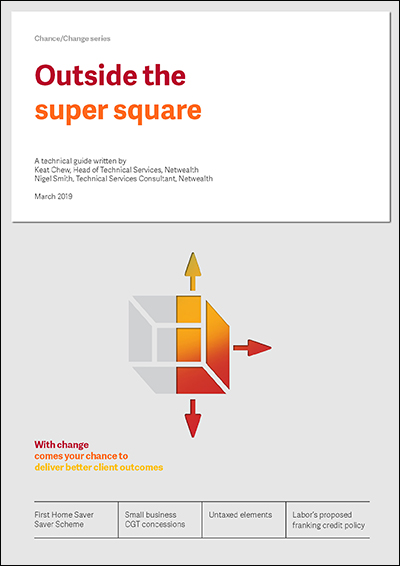The recent webinar hosted by Keat Chew – “New super changes, new planning opportunities” – highlighted quite a lot of interest in the proposed new rules around the First Home Super Saver Scheme, the proposed $300,000 downsizer contribution rules as well as opportunities arising from the newly legislated carry forward unused concessional contribution rules.
Below, Keat answers some of the recurring questions from the webinar to help you navigate the super changes.
If you would like further detail and context when reading the Q&As, you can download the Netwealth Technical Guide written by our Technical Services team.
First Home Super Savers Scheme (FHSSS)
The first thing to remember is that this is a proposed measure. We have only just received the “exposure draft” legislation and explanatory memorandum (EM) so it could be some time (if ever) before we see the final rules and they could be substantially modified from those currently presented in the exposure draft.
Q. Is there an income limit that affects being eligible for the FHSSS?
A. No, the draft rules make no mention of there being an upper limit on the income of the first home saver either as an individual or as a couple.
Q. Can the measure be applied retrospectively (i.e. the couple has already purchased their first home and owe a mortgage)?
A. The EM states that to qualify for the FHSSS, amongst other criteria, you must never have owned real property in Australia. Therefore, if you already owned property prior to qualifying for FHSSS, you would fail this criteria.
Q. Will the FHSSS withdrawal impact Family Tax Benefits A & B?
A. There are two possible ways the FHSSS could impact Centrelink related income support benefits. Do the contributions you make to super under FHSSS reduce your income for the income test? The answer seems to be - “NO”. The income test for Family Tax Benefit A & B is an adjusted income that captures taxable income and reportable superannuation contributions effectively capturing both concessional and non-concessional contributions. Thus, while there is no additional penalty, there is no benefit. Secondly, does the amount released adversely impact on such payments? The EM specifically states that FHSSS released amounts will be excluded in determining your income for certain Centrelink payments such as Family Assistance, Child Support and certain other support payments.
Q. Can you take money out of FHSS even if you don’t intend to purchase a property after two years?
A. No. If you do not purchase your first home within 12 months, you can either recontribute the release amount, or pay the first home super saver tax equal to 20% of the released amount to unwind the concessional tax treatment that applied on release.
Q. Are only First Home Owners eligible? What if a partner has a property and you don’t have one?
A. You may still qualify even where your partner is not a first home buyer. [Ref: FHSSS Fact Sheet]
Q. Is it only funds contributed post 1/7/2017 that can be withdrawn under the legislation?
A. Yes, we believe so. The EM states that the ATO will identify the maximum release amount based on past contributions and associated earnings. The draft legislation at sec 138-20 and 25 determines how to calculate the maximum release amount and states “Your FHSS releasable contributions amount is the sum of the following amounts for each financial year that starts on 1 July 2017 or a later 1 July…”
Outside the super square: Alternative super strategies
This guide explores four alternative super strategies, to get you thinking differently about superannuation.
$300,000 Downsizing contributions
Once again, we suggest that you exercise caution when talking to your clients about this opportunity as the measures are currently only proposed and in draft form. There could be significant changes to the final measures assuming they are passed into legislation at all.
Q. Does home downsizing create a CGT contribution to super?
A. No as it only applies to sale proceeds from a dwelling where any capital gain is wholly or partially disregarded [Ref: proposed ITAA 292-102]. The EM at paragraph 2.19 and 2.20 provides some further detail saying for CGT purposes, broadly, a capital gain or loss made on a dwelling that is an individual’s main residence is disregarded. ‘Main residence’ is not defined and takes its ordinary meaning. It is possible that a capital gain may be partially disregarded. This may occur where the dwelling has been the main residence for only a part of the individual’s ownership period.
Q. If the land is bought a few years before commencement of building the Owner Occupier Home, can the period of ownership of land be counted in or do you have to have moved in?
A. Partially. The definition above refers to the sale of a dwelling that is a main residence and any capital gain (or loss) is exempt. The ATO’s stated position on what constitutes a main residence states that “… you can treat the land as your main residence for up to four years before you move in, provided you move in as soon as practicable after it's finished.”1
Q. Is there a time limit on downsizing contribution? E.g. Does the contribution have to be made within 12 months of the house sale, or in the same financial year?
A. Yes. The contribution must be made within 90 days of the disposal – generally the date of settlement – of the main residence.
Contributions
Q. How is the (unused) carry forward (amount) going to be tracked and by whom?
A. Good question! There are two components that must be tracked – the Total Super Balance and the unused amount that can be carried forward. The ATO will have this information and we assume individuals will be able to access it. The individual should also be aware of this information. Super funds definitely will NOT be able to track it as individuals may contribute to more than fund.
Q. For employed people to claim the (personal) deduction for super, is the ‘notice of intent claim’ required?
A. Yes, the existing rules have not changed.
Q. In regards to splitting contributions with your spouse, is it still 85% of contributions even for those subject to Division 293 (high income earners super tax) who ultimately pay 30% on their capital contributions.
A. Not really. The splittable amount is “up to 85%” of a financial year’s taxed splittable contributions. [Ref: ATO Contributions Splitting form]. SIS Regulation 6.41 defines taxable splittable contribution (broadly) as a contribution that is included in the assessable income of the fund. Therefore in the case of a member subject to the Division 293 tax, the splittable amount will be 70% of the concessional contribution.
Q. Can you (contribution) split (up to) 85% of the 5-year concessional contribution to your spouse?
A. Yes – the two issues, being the amount able to be contributed and the amount able to be split, are calculated separately. The amount able to be split is based on the splittable amount, as defined above, not a fixed dollar amount.
Q. Can you make a lump sum concessional contribution if you are salaried employee?
A. Yes - From 1 July 2017, with the exception of Commonwealth public sector and untaxed fund members, individuals are able to deduct personal contributions, regardless of whether they earn 10% or more of their total income from employment or related activities. All other current requirements, including notice to the trustee, for deducting personal contributions need to be met.
Q. When you make carried forward concessional contributions (CC) do you have to make sure the starting balance is under $500k? For example, if the balance is $450k and the carried forward CC is $100k buffer, will that be okay?
A. Yes. From 1 July 2018, it is the balance just before the start of the financial year in which the concessional contribution is made that determines the ability to contribute, not the balance after the contribution is made.
Q. Does the no deduction rule to Constitutionally Protected Funds impact upon Salary Sacrifice arrangements?
A.Yes. Contributions and amounts in respect of these funds and other unfunded defined benefit funds count toward the individual’s concessional contributions cap. This means that these contributions will impact the individual’s ability to make further concessional contributions. [Ref EM page 137]
If you would like further information, you can email or contact us on 1800 888 223.




